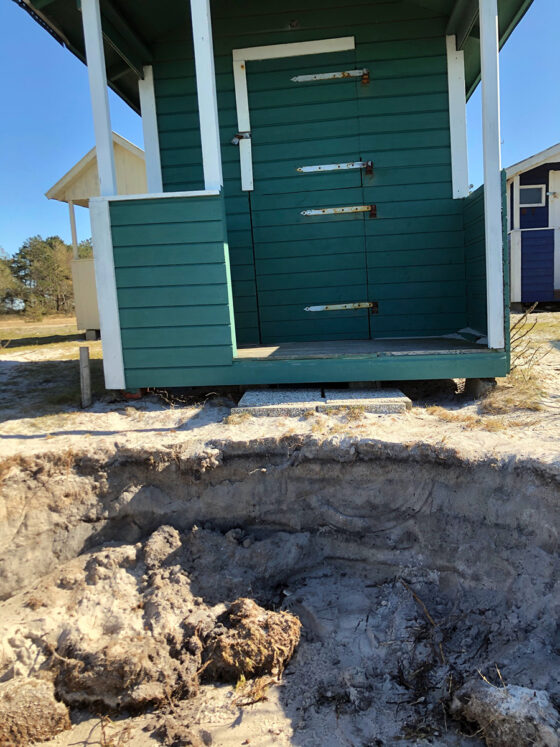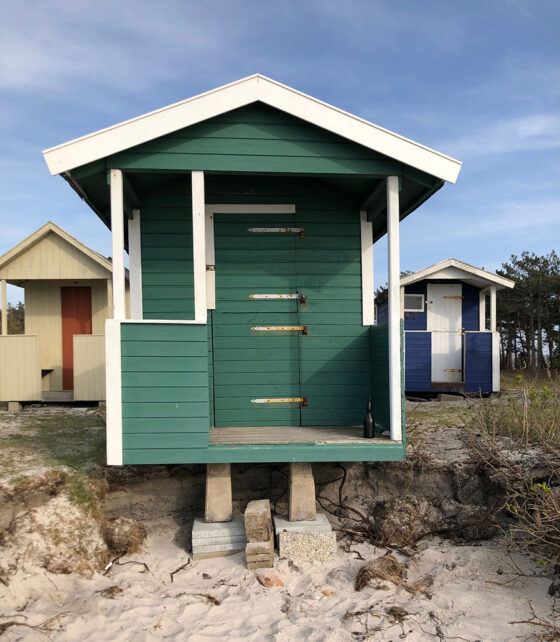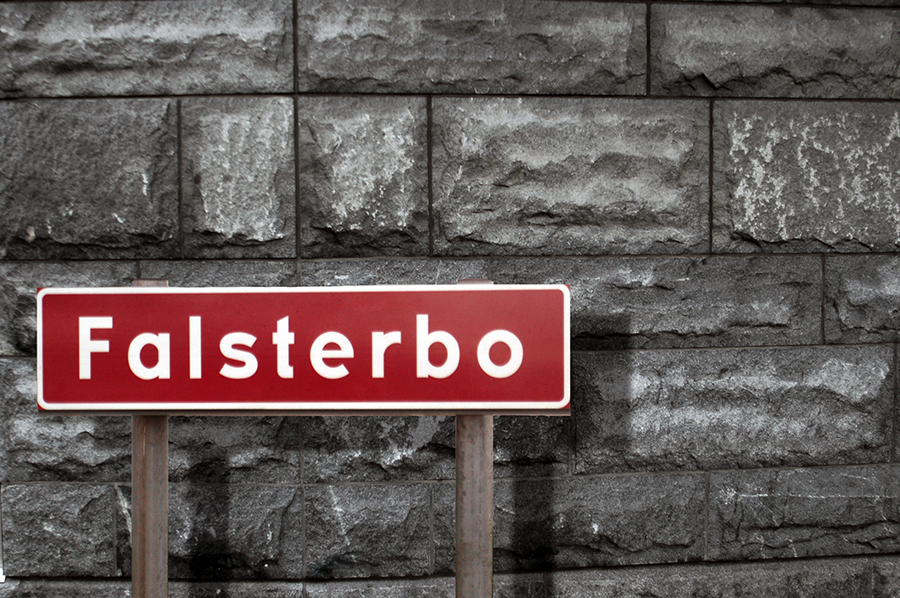Is this the future that awaits Falsterbo? (Photo: Peter Goddard. This image is photoshopped.)
“Your next-door neighbour is the sea” was the headline for a recent property ad for an expensive house located on the south coast of Sweden. “The sea could soon be moving in” would probably be a more accurate but less selling headline.
The copy of the ad went on to state “With a sea view” but the truth in future could be “With a view of a sea wall or dike”. This is the future outlook for many houses located on the popular peninsula known as Näset at the southwestern tip of Sweden.
This area is part of the Vellinge municipality where the local council has instigated a large engineering project to build a 21-km long barrier against the sea. This sea defence will enclose parts of Falsterbo, Skanör and Ljunghusen. It will be up to 1.5 metres high for about 80% of the 21 km stretch and higher for the rest depending on the local topography. Many other municipalities in the southern part of Sweden may have to follow Vellinge’s example by fortifying their sea defences if the negative effects of climate change on sea levels continue.
According to the Swedish Meteorological and Hydrological Institute (SMHI), based on a continuing increase of carbon emissions, sea levels will rise by up to 40 cm by the year 2050 and by up to one metre by 2100 along the coastline near Vellinge. If this is the case and nothing is done, many properties in Falsterbo and Skanör risk being flooded with seawater in about 80 years, if not sooner.
“I have reported from many places around the world about how the poorest people are being affected by rising sea levels… In Sweden, the opposite is true. The rich in the county of Skåne will be hit first. The narrow Falsterbo peninsula sticks right out into the sea along the coast of Skåne. Members of the Wallenberg family, other rich business leaders, retired politicians, artists and TV celebrities all live here,” writes Erika Bjerström, climate correspondent for the Swedish public broadcasting corporation, SVT, in her book in Swedish entitled Klimatkrisens Sverige (The Climate Crisis in Sweden).*
According to Erika Bjerström, properties here are worth a total of SEK 70 billion. But what will happen to house prices in future if sea levels continue to rise?


About 30 years ago, there was a wide beach here in Skanör full of bathers in the summer. Today, the beach has receded to a narrow strip and the beach huts are under threat. Erosion can proceed at a fast pace. On 21 March 2020, this particular hut was still upright but about three weeks later, it was in danger of subsiding. The huts are an early warning of how the sea is encroaching on the coastal communities of Skanör, Falsterbo and Ljunghusen. These towns are at the frontline in Sweden for the threat of rising sea levels caused partially by a gradual lowering of the land mass in this area and partially by climate change.
The photos of a beach hut in Skanör give a hint of what could await properties on the Falsterbo peninsula if they are left to the ravages of the sea and high water. Walls or dikes are necessary to avoid incursions by the sea in future. Many coastal communities in southern Sweden could become like the Netherlands where dikes are needed.
This may all seem like me spreading doom and gloom but I write this article to point out that climate change is affecting people here and now in Sweden. Many Swedes I know are simply ignoring this fact or in denial. Climate change is not something abstract happening in poor countries on the other side of the world. Some of the richest people in Sweden are now in the frontline for rising sea levels.
Everyone in society can still do something to avoid the release of more carbon emissions into the atmosphere, which is scientifically proven to raise global temperatures. This leads to melting tundra, glaciers and ice fields pouring into the sea. As the oceans become warmer, the water expands to fill a greater volume, causing a further rise in sea levels.
I myself have tried to influence local opinion and politicians here in Skåne where I live. Indeed, I had an opinion piece on this subject published in August 2020 in the Skåne newspaper Skånska Dagbladet and in another local paper Sydsvenskan in September 2021. This article was written in Swedish and you can see it by following the link at the end or by viewing a PDF here .
Climate apathy and climate anxiety are big problems as we are frequently exposed to gloomy stories in the news of the effects of climate change. But a coming climate catastrophe is not inevitable. There are hopeful stories of progress and practical solutions to the climate crisis as well as many organisations working for this cause such as WWF, Greenpeace, Citizens’ Climate Lobby, the Swedish Society for Nature Conservation and Fridays for Future. Sweden had at least three political parties in the last election with a strong environmental and climate manifesto: The Green Party (Miljö Partiet de Gröna), Klimatinitiativ and Partiet Vändpunkt.
I try to do my part, however small. Climate activists like Greta Thunberg inspire us that “No one is too small to make a difference” – the title of Greta’s first book. I quote from this book:
“There are no grey areas when it comes to survival. Now we all have a choice. We can create transformational change that will safeguard the living conditions for future generations. Or we can continue with our business as usual and fail. That is up to you and me.”
*Here is the original quote in Swedish from Erika Bjerström’s book that I have translated: ”Jag har rapporterat från flera platser i världen om hur de allra fattigaste drabbas av havsnivåhöjningar … I Sverige är det tvärtom. Det är de mest välbeställda i Skåne som kommer att drabbas först. Det smala Falsterbonäset sticker rakt ut i havet från den skånska kusten. Här bor medlemmar i familjen Wallenberg, andra förmögna företagsledare, pensionerade statsråd, artister och kända tv-personligheter.”
Link to my opinion piece in Swedish: https://www.sydsvenskan.se/2021-09-14/det-ar-de-mest-valbestallda-i-skane-som-drabbas-forst
By Peter Goddard

